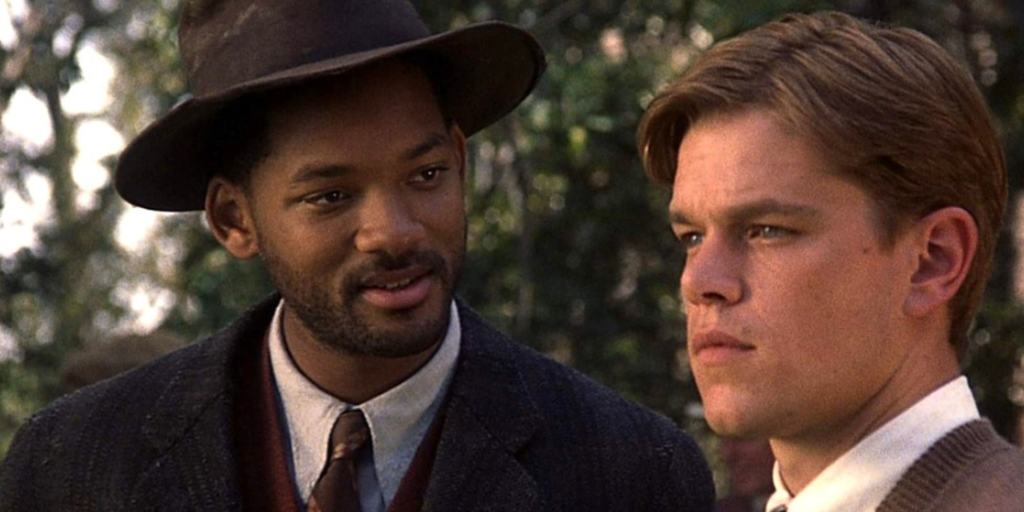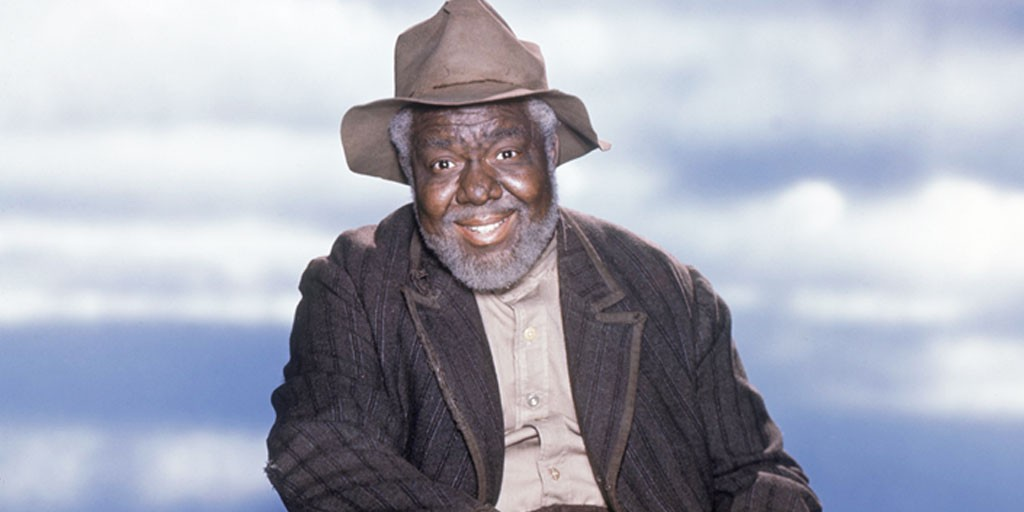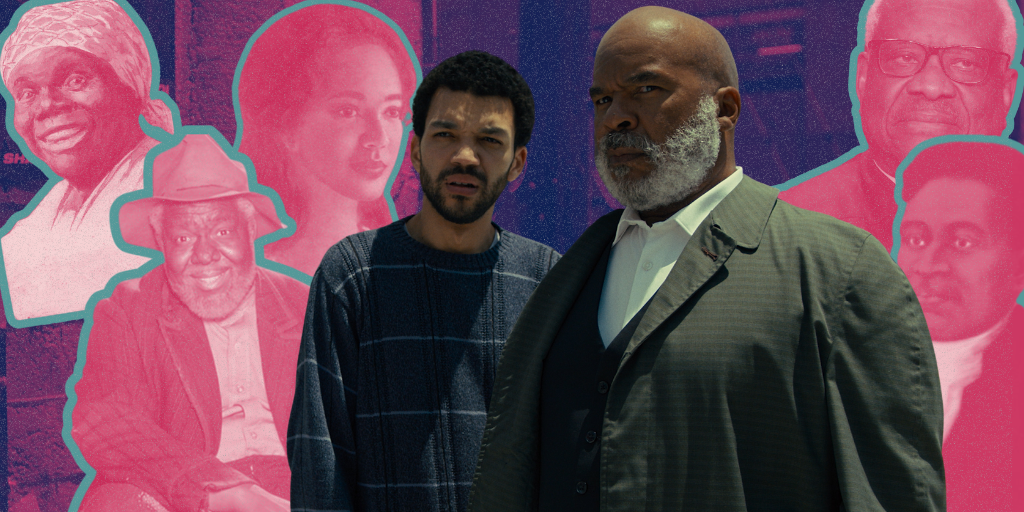Some of the “magical Negroes” mentioned in The American Society of Magical Negroes aren’t actually “magical Negroes.” Photo: Focus Features/Universal Pictures
I am not happy with The American Society of Magical Negroes.
I hate it.
Starring Justice Smith, David Alan Grier, An-Li Bogan, Aisha Hinds, and Nicole Byer, The American Society of Magical Negroes is a film that desperately wants to be seen as a highfalutin, edgy, thoughtful, and unique cultural commentary about race. But all I got from the film was that its writer/director, Kobi Libii, seems like he just discovered he was Black. It also seems like he has learned all the wrong lessons about being Black.
My review for Common Sense Media was a kinder way of saying that I got nothing from this film. In fact, I got tons of evidence for my statement regarding Libii’s newfound exploration of his Blackness from how the film doesn’t know about or properly recognize the real struggles of Black people. It’s through those who courageously said “No” to injustice that we are where we are today, not because of Uncle Toms.
The most significant, egregious part of the film–aside from asserting the falsehood that magical Negroes have offered us protection from whites and have afforded us the privileges (and literal rights) we have today–is that the film doesn’t understand the nuance in calling someone out for uncomfortably centering whiteness versus someone existing. In other words, the movie tries to label real-life Black historical figures as “magical Negroes,” even though many were simply trying to survive in a racially violent climate. They did what they had to do, not because they had a choice (as the magical Negroes in this film do), but because they wanted to survive for themselves and their families.
Let’s break it down.
What a ‘Magical Negro” is–and isn’t

A “Magical Negro,” as defined by the Oxford Languages Dictionary, is:
(in films, books, etc.) a stereotyped Black character (generally regarded as an offensive representation of Black people) whose role primarily involves assisting a white protagonist, typically by providing magical assistance or folk wisdom. (Oxford Languages Dictionary)
Key point: “in films, books, etc.” Meaning that “magical Negroes” AREN’T. REAL.
Spike Lee coined the term in 2001 when he spoke at Yale’s then-named Calhoun College about Black images in film. He cited four films containing what he called the “magical, mystical Negro.” Those films include The Family Man, What Dreams May Come, The Legend of Bagger Vance, and The Green Mile. As he talked, he asked the audience, “How is it that Black people have these powers, but they use them for the benefit of white people?… Blacks are getting lynched left and right, and [Bagger Vance is] more concerned about improving Matt Damon’s golf swing!”
Lee described the “magical Negro” trope as a continuation of the “stereotype or caricature of African Americans as the ‘noble savage’ or the ‘happy slave.'” He’s right: the “magical Negro” stereotype is just another version of these older, harmful tropes that only serve to appease the white imagination about the Black plight–a plight white society caused through enslavement, discrimination, death, and violence, both physically and sexually.
The “noble savage” gives whiteness a stoic yet “untamed” character, representing the nobility and wildness of nature. The “noble savage” can’t be tamed, much like nature. Still, the character also presents a challenge to the white protagonist–maybe the “savage” can be tamed after all, especially if whiteness gets stereotyped as the master tamer.
On the other hand, a “happy slave” is one you would see in a film from the early days of filmmaking up until the 1950s or even early 1960s. Think singing and smiling Uncle Remus from Disney’s stain of a movie, Song of the South. This character smoothes over the harsh realities of slavery and allows white people not to feel guilty about their ancestors having possibly engaged in inhumane practices. White people created these characters so they could then say, “See? Slavery wasn’t bad for anyone! See how happy these enslaved people are? We were doing something good for them!” What the “good” is, I don’t know–some would argue enslavers were “civilizing” the “uncivilized” (again, the “noble savage” comes into play here) or that they were giving them work and were mere 9-5 bosses with hordes of laborer happy to take care of their families. Both are, of course, wildly false. The “happy slave” allows white people to ignore the racial and power imbalances; instead, slavery is just “how things were,” a benign part of southern society in the 1800s.
(It’s worth noting that Calhoun College was renamed to Hooper College in 2017 after Grace Murray Hooper, a Yale alum, computer scientist, and U.S. Navy Rear Admiral. The college was renamed because of the university’s board of trustees’ decision to acknowledge “John C. Calhoun’s legacy as a white supremacist and a national leader who passionately promoted slavery as a ‘positive good’.” The board found that Calhoun’s legacy “fundamentally conflicts with Yale’s mission and values,” according to Yale President Peter Salovey.)

What a “magical Negro” isn’t, however, is a real person who is doing what they can to survive in a majority-white (and violent) society. I’m talking about your everyday people who have had to stuff down their feelings to make sure they came home unscathed at the end of the day. That could be anyone.
The film shows its confusion on the difference between the trope and reality when Grier’s character Roger relates a memory of his father smiling in the face of white violence. His father, a shoe-shiner, got spat on by a white customer. The white customer said “he needed more spit in his shine,” according to Roger. Instead of fighting back, Roger said his father smiled, wiped the spit off, and kept working. When little Roger told his grandmother, his grandmother said that Roger shouldn’t be upset with his father; what his father did was make sure he could come home safely by not fighting back.
This is a story that could be applied to a lot of different scenarios during the heyday of America’s white supremacy. If you lived in a society in which even looking a white person in the eye could get you killed, of course, you’d bite your tongue. Even in my family, there are stories of my late grandfather looking down and kissing up to white people in 1960s Bessemer, AL. Unfortunately, my grandfather also wasn’t a nice person, so there’s a lot I’m purposefully leaving out of the story regarding how he behaved at home. He was so bad that my dad reportedly didn’t even feel sorry when my grandfather died–instead, he felt something akin to relief. Regardless of my grandfather’s poor behavior as a human being, one of the myriad of reasons he might have been so terrible, leaving my dad determined to break the generational trauma (which he thankfully did), is because he was taking his anger out on his family instead of the people who deserved it. If he couldn’t get mad at white people without threatening his life, the only other people he could hurt without repercussions would be those closest to him.
A “magical Negro” also isn’t someone who is an “Uncle Tom,” even though the two have overlapping “symptoms,” if you will. An “Uncle Tom” might also be a plot device, but it’s a stereotype that has become a real-life slur. An “Uncle Tom” is a “magical Negro” trying to function in reality. An “Uncle Tom” might align itself with whiteness to an uncomfortable degree, at the expense of their morality, self-esteem, self-love, and self-worth (like Supreme Court Justice Clarence Thomas, for example), but a “magical Negro” feels no conflict about this decision. An “Uncle Tom,” i.e., a real person trying to function like a storytelling trope, might feel internally disgusted with themselves, no matter how hard they try to bury it. They might succeed in burying their self-disgust so profoundly that they don’t even feel it, but it’s still there, seething and seeping out of their pores.
A “magical Negro” doesn’t hate themselves. An “Uncle Tom” does.
A “magical Negro” also can’t be cured of their “magical Negro”-ness. An “Uncle Tom,” on the other hand, can be cured. They can get tired of serving whiteness. They might start questioning why they even hate their Blackness and why they love whiteness so much. They can grow and become reformed. We’ve seen it happen with Don Lemon in real-time.
So now that we know what a “magical Negro” is and isn’t, I have to ask a question that I’d love to ask Libii himself. Does he realize that slaves aren’t “magical Negroes”?
View this post on Instagram
Enslaved people can’t choose to become “magical Negroes”
Libii’s insistence that real people can be “magical Negroes” is one of the reasons why the film seems like his own musings on discovering how Blackness works in America. What’s sad is that the film shows he still doesn’t get it because trying to lump Crispus Attucks, Nancy Green, and the enslaved people of Monticello as “Magical Negroes” is highly confusing and ill-advised. To say the most, Libii is denigrating the struggles these people lived through and acting as if they had tons of agency and privilege to decide to kowtow to whiteness.
The film calls out these individuals as the cornerstones of the Society of Magical Negroes. The Monticello slaves were the founders, according to this film’s paper-thin lore. They decided that they would work to help white people feel comfortable to save Black lives. It’s a thought process that doesn’t even make sense in the film’s world, much less in the real world, because the film fails to factor in the hundreds of years’ worth of freedom fighters, liberators, revolutionaries, and martyrs that have allowed us modern Black people the rights we do have. If we go by the film’s logic, how could the enslaved people at Monticello have helped us “be safe” when, even within the film, Black people are still apparently targeted by the police and seen as unsafe to white people?
Aside from this convoluted point, acting as if the enslaved people on Thomas Jefferson’s estate had choices is comical at best and insulting at worst, especially when you think about the most infamous of Jefferson’s property, his “concubine” Sally Hemings. To be clear, Hemings wasn’t mentioned by name in the film, but she was enslaved at Monticello. Is the film suggesting that Hemings was “taking one for the team” when Jefferson forced her to be his literal sex slave? Even more alarming, is the film implying that she chose to do it?
Sally Hemings was the property of Jefferon’s wife Martha and was a servant to their daughter Maria (Hemings was 14, about the same age as Maria). When Jefferson, Maria, and Hemings went to Paris, Hemings returned as Jefferson’s “concubine,” as written in records on Monticello.org. In reality, Hemings more than likely had no say in refusing Jefferson’s sexual advances, meaning she was more than likely a sexual abuse survivor.
However, she was still able to negotiate freedom for the children she had for Jefferson. Despite Jefferson agreeing to free her children, he never freed her; she was only freed after Jefferson’s death and allowed to live with her sons.
Hemings was not someone who chose to be like Olivia Pope and have a relationship with the President of the United States. No matter how much you try to “Olitz” this relationship, Hemings’ life with Jefferson was not full of agency and personal freedom. She might have been treated a smidge better than the other enslaved people, but she was still, in fact, enslaved.
Green, who Libii writes in as another Society operative, was also an enslaved person for much of her life. According to Wikipedia, Green was born Nancy Hayes (or Hughes) in slavery in 1834 in Kentucky. She farmed alongside her husband, George Green, and had various domestic jobs within the Walker family household. She served as a servant, nurse, nanny, housekeeper, and cook, and she served several generations of Walkers, including brothers Chicago Circuit Judge Charles M. Walker Jr. and Dr. Samuel J. Walker.
She lived with the Walkers after her husband and children died at the end of the Civil War. The Walkers moved to Chicago, which led to Judge Walker recommending her to the R.T. Davis Milling Company as the person who could portray Aunt Jemima, a mascot named after a minstrel show song. It’s not clear if Green had a choice in whether she wanted to portray this character; all we know is that her master-turned-employer told her to.
She debuted as the character at 59 years old during the 1893 World’s Colombian Exposition in Chicago. She worked a pancake-cooking display, sang, and told fake stories about how southern life was happy for both Blacks and whites. In this way, she was portraying the “happy slave” stereotype and evoking a false nostalgia for white people about how things were before the Civil War.
Attucks himself also was probably enslaved before he became a sailor and martyr for American Independence.
Attucks, an African-Indigenous man, was born in Framingham, MA. According to the National Park Service, his first name is in line with a trend among slaveholders at this time of giving slaves Ancient Roman names. His last name, “Attucks,” provides proof of his Indigenous ancestry since it derives from the Natick word for “deer.” Attucks also went by the name “Michael Johnson,” probably to keep himself from returning to servitude. That means he might have escaped slavery and used the name to keep himself free.
Attucks made a new life for himself in the Bahamas and was sailing to North Carolina at the time he got caught up in the brawl that led to his death. According to eyewitnesses, Attucks was leading sailors against the British soldiers, and the sailors were using ice and snowballs as weapons. Attucks himself had a club in his hands. Attucks was the first killed. Just like today with police brutality, Attucks (and the other sailors) were painted as the aggressors by John Adams, who were representing the soldiers, and were described as “a motley rabble of saucy boys, Negroes, and mulattos, Irish teagues and outlandish jack tars.” The captain and all but two of the soldiers were acquitted.
View this post on Instagram
A movie full of nothing and wrong lessons
What can we learn from all of this? I think the main thing is that if you are trying to see this movie to learn something about racism and stuff, you shouldn’t. You won’t be able to learn anything of substance.
This film is a very sad waste of time and makes me wonder what echo chamber Libii used to come up with this idea. It seems like Libii, like Smith’s character in the film, is surrounded by white people who want to utilize his “wisdom” about Blackness for their gain. However, they don’t realize that Libii needs some education himself.
